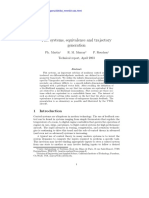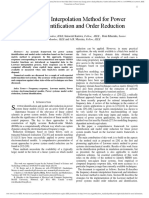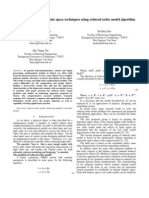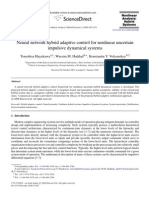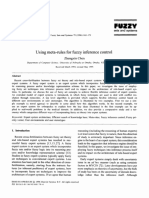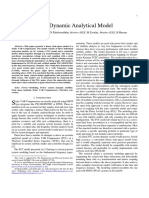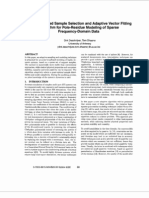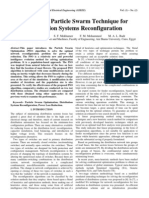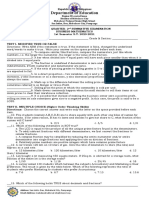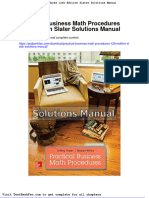Professional Documents
Culture Documents
Comparative Study of Model Order Reduction Techniques
Copyright
Available Formats
Share this document
Did you find this document useful?
Is this content inappropriate?
Report this DocumentCopyright:
Available Formats
Comparative Study of Model Order Reduction Techniques
Copyright:
Available Formats
Volume 8, Issue 5, May – 2023 International Journal of Innovative Science and Research Technology
ISSN No:-2456-2165
Comparative Study of Model Order
Reduction Techniques
Manoj Lavanshi Dr. D. K. Sambariya
Department of Electrical Engineering Department of Electrical Engineering
Rajasthan Technical University Rajasthan Technical University
Kota, Rajasthan (324010) Kota, Rajasthan (324010)
Abstract:- The higher order system consumes more space The Problem Associated with Model Order Reduction as
because to higher order matrix. The higher order follow:
interconnected power systems stability analysis is time The Error of Approximation should be Minimum.
consuming and large system performance of the system
cannot be understanding easily. The analysis of the higher
The original system's characteristics must be kept
system is drudging and inordinate. The analysis and
protected.
control of such system presents a great challenge for
The computation of the reduction of system should be
system engineer. The lower order system drives a comfort
well-organized or sequential.
exploratory and optimization which results in favorable
similarity to the system. This paper's objectives are to The reducing procedure need to be automated[5-7, 9-
examine the reduced order model of large scale LTI 15].
system using balanced truncation method. In this
technique the reduction of nominator and denominator For linear time invariant (LTI) dynamic system various
polynomial using balanced truncation (BT) method, reduction methods are proposed for model order reduction of
which results more accurate result. This approach higher order system. The technique which are more
preserves the original system's stability and steady state frequently used for matching the time moments of original
value in the lower order model. and reduced system is pade approximation. But this technique
has a drawback that it has potential to give unstable lower
Keywords:- Reduction Techniques, Stability Equation Method order reduced order model for stable higher order system.
(SEM), Differentiation Equation Method (DEM), Balanced Routh stability reduction technique is commonly used for
Truncation Method, Reduced Model. the reduction of the complexity and matching the transient
response of higher order system with lower order system.
I. INTRODUCTION Unfortunately, it also has limitation to defend the dominant
poles in the reduced order model for a non-minimum phase
system it lags.
Modelling is the process of brief explanation of a
system using mathematical equations and matrix. The
In this paper, for linear time-invariant system, a mixed
mathematical models have a capability of better
method approach is proposed for model order reduction. In
understanding of a system and how it can be control[1-4].
this paper the Stability Equation Method, Differential
The mathematical modelling is used in different fields like,
Equation method and Balanced Truncation Method is used to
power system, control theory and sociology and physiology
reduce a higher order LTI system to a reduced order system.
etc. Study of a mathematical model which has many states
Now to obtain desired reduced order model again reduce the
variables behaviour [5]. The construction of a system or
intermediate lower system.
model which is nearly similar to real phenomenon. A large-
scale order system is therefore challenging to analyse and
II. STATEMENT OF PROBLEM
simulate in terms of synthesis and control. This also affects
the computational time due to large number of system
Considering a higher order (𝑛𝑡ℎ ) system and a reduced
variables [6].
order (𝑟 𝑡ℎ ) system may be represented as following:
The method of getting an approximation reduced order
∑𝑛−1
𝑖=0 𝑚𝑖 𝑠
𝑖
of a big system with the same properties as the real original G(s)= (1)
∑𝑟−1
𝑖=0 𝑙𝑠
𝑖
system is called "model order reduction". The development of
optimal model order reduction and its generalisation to ∑𝑟−1 𝑞𝑖 𝑠 𝑖
discrete time non-linear systems [7]. There are various model R(s)= ∑𝑟𝑖=0 𝑗 (2)
𝑖=0 𝑝𝑗 𝑠
order reduction techniques are available which are published
in earlier years some of them are Hankel Norm
Where, 𝑚𝑖 , 𝑞𝑖 are scalar constants for numerator and
Approximation, Stability Equation Method, Singular Value
𝑝𝑗, 𝑙𝑗 , are scalar constants for denominator of higher order and
Decomposition, Pade Approximation Technique, Routh
Stability Method, Pade Via Lanczos [8]. reduced order system, respectively. The objective is to find a
reduced 𝑟 𝑡ℎ order system model R(s) such that it retains the
IJISRT23MAY1465 www.ijisrt.com 1441
Volume 8, Issue 5, May – 2023 International Journal of Innovative Science and Research Technology
ISSN No:-2456-2165
important properties of the original higher system model G(s) The Equation May be written as
for the same type of inputs. The analysis is done by two
𝑘
different reduction method viz stability equation method and 1
𝑁𝑒 (𝑠) = 𝑏0 ∑𝑖=1 (1 + 𝑠 2 /𝑧𝑖2 ) (12)
differentiation method. The graphical and analytical analysis
of reduced order system is to be carried out. 𝑘
2
𝑁𝑜 (𝑠) =𝑏1 𝑠 ∑𝑖=1(1 + 𝑠 2 /𝑝𝑖2 ) (13)
III. METHODOLOGY
Where 𝑘1 and 𝑘2 are integer parts of n/2 and (n-2)/2
respectively.
For model order reduction various techniques are
proposed, but here we are using these two methodologies Here 𝑧12 < 𝑝12 < 𝑧22 < 𝑝22 ……… by ignoring the factor
which are: with higher magnitude of 𝑧𝑖 & 𝑝𝑖 , we get thee desired reduced
order ‘r’ of stability equation and it can be written as
A. Stability Equation Method
In this technique the reduced order transfer function is 𝑟
1
𝑁𝑒𝑟 (𝑠) = 𝑏0 ∑𝑖=1 (1 + 𝑠 2 /𝑧𝑖2 ) (14)
gained straight from the pole zero arrangement of stability
equations of the original higher order transfer function. Hence 𝑟
the order of the higher order transfer function of stability
2
𝑁𝑜 (𝑠) = 𝑏1 ∑𝑖=1 (1 + 𝑠 2 /𝑝𝑖2 ) (15)
equation can be reduced [14].
Where r1 andr2 are the integer parts of r/2 and (r-2)/2
Let us Assume that the Transfer Function of the Higher respectively. The reduced order numerator formed as:
Order System is:
𝑁𝑟 (𝑠) = 𝑁𝑒𝑟 (𝑠) + 𝑁𝑜𝑟 (𝑠) (16)
𝑏𝑚 𝑠 𝑚 +𝑏𝑚−1 𝑠 𝑚−1 + ………. 𝑏1𝑠+𝑏0
𝐺(𝑠) = (3)
𝑎𝑛 𝑠 𝑛 +𝑎𝑛−1 𝑠 𝑛−1 + …..….𝑎1 𝑠++𝑎0 Similarly, the Reduced Order Denominator is Obtained:
𝑁(𝑠) and 𝐷(𝑠) are the Numerator and Denominator of 𝐷𝑟 (𝑠) = 𝐷𝑒𝑟 (𝑠) + 𝐷𝑜𝑟 (𝑠) (17)
considered transfer function 𝐺(𝑠) respectively. By separating
the numerator 𝑁(𝑠) and denominator 𝐷(𝑠) into their even The Reduced Order Transfer Function R(S) is Written
and odd parts we get as:
𝑁𝑒 (𝑠)+𝑁𝑜 (𝑠) 𝑁𝑒𝑟 (𝑠)+𝑁𝑜𝑟(𝑠)
𝐺(𝑠) = (4) 𝑅(𝑠) = (18)
𝐷𝑒 (𝑠)+𝐷𝑜 (𝑠) 𝐷𝑒𝑟 (𝑠)+𝐷𝑜𝑟 (𝑠)
Where, As the result of the stability equation method, we get
stable reduced order models. It is observed that poles and
𝑁𝑒 (𝑠) = ∑𝑚
𝑖=2,2,4 𝑏𝑖 𝑠
𝑖
(5) zeros of lower models have a greater degree of dominance
than those of higher magnitude. In this method, the poles or
𝑁𝑜 (𝑠) = ∑𝑚
𝑖=1,3,5 𝑏𝑖 𝑠
𝑖
(6) zeros with higher magnitudes ore disregarded.
𝐷𝑒 (𝑠) = ∑𝑛𝑖=0,2,4, 𝑎𝑖 𝑠 𝑖 (7) B. Differentiation Equation Method-
This method was introduced by Gutman et al. [14]. This
𝐷𝑜 (𝑠) = ∑𝑛𝑖=1,3,5 𝑎𝑖 𝑠 𝑖 (8) method based on polynomial’s differentiation. The
differentiation approach of Gutman et al. may also be
considered a multipoint pade method; it is another stability
The roots of the even part of numerator 𝑁𝑒 (𝑠) and
preserving method. Any reduction technique in the frequency
denominator 𝐷𝑒 (𝑠) are called zeros 𝑧𝑖 (𝑠) while the odd part
domain that obtains the lower order models, as a result of this
of the numerator 𝑁𝑜 (𝑠) and denominator 𝐷𝑜 (𝑠) are called
novel connection between the pade and stability preserving
poles 𝑝𝑖 (𝑠). In this method, we reduce a polynomial’s less
methods.
significant factor by individual eliminating. Let us illustrate
the method by reducing the numerator and the denominator is
The coefficient of the reduced order transfer function is
reduced as well. The reduced order model is attained by the
produced by differentiating the reciprocal of the numerator
ratio of reduced numerator and denominator.
and denominator polynomial of the higher transfer functions
repeatedly. The differentiated reduced order is reciprocated
The Numerator is Separated as:
again and normalized reduced polynomials are used. Because
of the problem that zeros with big modules tend to be better
N(s) = 𝑁𝑒 (𝑠) + 𝑁𝑜 (𝑠) (9) approximation than those with a small module, the
straightforward differentiation is abandoned.
Were
𝑁𝑒 (𝑠) = 𝑏0 + 𝑏2 𝑠 2 + 𝑏4 𝑠 4 +… (10)
𝑁𝑜 (𝑠) = 𝑏1 + 𝑏3 𝑠 3 + 𝑏5 𝑠 5 + … … … (11)
IJISRT23MAY1465 www.ijisrt.com 1442
Volume 8, Issue 5, May – 2023 International Journal of Innovative Science and Research Technology
ISSN No:-2456-2165
Algorithm of Differentiation- lower order state space matrix is again transformed into the
transfer function equation.
The Reciprocal of the Transfer Function is Taken.
To Get the Desired Reduced Order the Reciprocated The input and output state space models are inversely
Transfer Function is Differentiated. correlated with the controllability and observability
The Reduced Transfer Function is Again Reciprocated Gramians. The controllability of the system is given by: -
The Decreased Order System is then Subjected to the
∞ 𝑇
Steady State Correction. 𝑃 = ∫0 𝑒 𝐴𝑡 𝐵𝐵𝑇 𝑒 𝐴 𝑡 𝑑𝑡 (25)
C. Balance Truncation Method Similarly, the observability of the system is given by:
Review on BTM- ∞ 𝑇
𝑄 = ∫0 𝑒 𝐴 𝑡 𝐶 𝑇 𝐶𝑒 𝐴 𝑡 𝑑𝑡
𝑇
(26)
This approach transforms the controllability Gramian
and the observability Gramian into a diagonal matrix for the
The two Lyapunov equations can be used to determine:
altered realisation [11]. Balance realisation is the name given
to this process. Balancing of a particular reality is the first
𝐴𝑃 + 𝑃𝐴𝑇 + 𝐵𝐵𝑇 = 0 (27)
stage in the balance truncation procedure.
𝐴𝑇 𝑄 + 𝑄𝐴 + 𝐶 𝑇 𝐶 = 0 (28)
Let us consider a LTI system in a state space form as: -
Diminution by Balanced Truncation Technique: -
𝑋(𝑡) = 𝐴𝑥(𝑡) + 𝐵𝑢(𝑡) (19)
There is a transformation procedure that, for every
stable dynamic system, renders controllability and
𝑦(𝑡) = 𝐶𝑥(𝑡) + 𝐷𝑢(𝑡) (20)
observability equal and in diagonal form. The idea of system
observability and controllability provides the basis for the
Where for each ‘t’,
combination of singular value decomposition, principal
component analysis, and the balanced truncation approach.
𝑢(𝑡)€𝑅𝑞 input vector,
Minimal Phase System: -
𝑥(𝑡)€𝑅𝑛 state vector,
Consider that (A, B) is observable, (A, C) is
controllable, and A, is stable. A matrix can be changed into if
𝑦(𝑡)€𝑅𝑝 output vector respectively.
it is symmetric and positive definite into the lower order
triangular matrix by Cholesky factorization method. The
The transfer function of original state space model is
Cholesky factor of lower triangular matrix are 𝐿𝑐 𝑎𝑛𝑑 𝐿𝑜 , of
obtained as: -
the P and Q.
𝐺(𝑠) = 𝐶(𝑠𝐼 − 𝐴)−1 𝐵 + 𝐷 (21)
𝑃 = 𝐿𝑐 𝐿𝑇𝑐 (29)
Here 𝐴, 𝐵, 𝐶 𝑎𝑛𝑑 𝐷 are the matrix of order 𝑛 ∗ 𝑛, 𝑛 ∗
𝑄 = 𝐿𝑜 𝐿𝑇𝑜 (30)
𝑞 𝑎𝑛𝑑 𝑝 ∗ 𝑞 in n-dimensional space R.
The matrix's singular value decomposition 𝐿𝑜 𝐿𝑇𝑐 ,
The objective is the higher order model to be
transformed into lower order model. The reduced order state
space equation is written as: - 𝐿𝑜 𝐿𝑇𝑐 = 𝑊∑𝑉 𝐻 (31)
𝑥𝑟′ (𝑡) = 𝐴𝑟 𝑥𝑟 (𝑡) + 𝐵𝑟 𝑢𝑟 (𝑡) (22) Here, W, V = orthogonal matrix, 𝑉 𝐻 =Hermitian
transpose
𝑦𝑟 (𝑡) = 𝐶𝑟 𝑥𝑟 (𝑡) + 𝐷𝑟 𝑢𝑟 (𝑡) (23)
The column of matrix u is referred to as a left single
vector and column of matric V is named as a single right
The state space matrix for reduced order into transfer
vector. The strength of controllability and observability for
function is written as: -
each specific state is obtained by Hankel singular values.
𝐺𝑟 (𝑠) = 𝐶𝑟 (𝑠𝐼 − 𝐴)−1 𝐵𝑟 + 𝐷𝑟 (24)
A dynamic system can be changed into a balanced
system by utilising the non-singular transformation T, which
The resulted error of output of both original and
is defined as
reduced model is kept low promising for input u(t).
1
The level of observability and control Gramians can be 𝑇 = 𝐿𝑐 𝑉 ∑−2 𝛼 (32)
used to measure observability and controllability in particular
state space directions. In this the transfer function equation of The balanced system matrix is obtained as.
higher order is transformed into equivalent state space model
then the matrix is reduced into the lower order matrix and the 𝐴~ = 𝑇 −1 𝐴𝑇, 𝐵 ~ = 𝑇 −1 𝐵, 𝐶 ~ = 𝐶𝑇 (33)
IJISRT23MAY1465 www.ijisrt.com 1443
Volume 8, Issue 5, May – 2023 International Journal of Innovative Science and Research Technology
ISSN No:-2456-2165
The transmission matrix D remain unchanged during the reduction process of original system. In a balanced system the
𝑃 ~ 𝑎𝑛𝑑 𝑄 ~ matrix became same and converted into diagonal matrix as
𝛼1 0 0 0 0 0 0
0 𝛼2 0 0 0 0 0
0 0 … 0 0 0 0
𝑃~ = 𝑄~ = ∑ 𝛼 = 0 0 0 𝛼𝑟 0 0 0 (34)
0 0 0 0 𝛼𝑟+1 0 0
0 0 0 0 0 … 0
[0 0 0 0 0 0 𝛼𝑛 ]
Where 𝛼𝑖 𝑖 = 1,2, … … , 𝑟, 𝑟 + 1, … … 𝑛 are Hankel singular values, listed in decreasing order as 𝛼1 > 𝛼2 > 𝛼3 > ⋯ > 𝛼𝑟 ≫
𝛼𝑟+1 > ⋯ > 𝛼𝑛 .
To calculate the desired order (r) reduced model the balance system (𝐴~ , 𝐵 ~ , 𝐶 ~ , 𝐷 ~ ) is partitioned as
𝐴11 𝐴12 𝐵
𝐴~ = [ ] , 𝐵 ~ = [ 1 ], 𝐶 ~ = [ 𝐶1 𝐶2 ], 𝐷 ~ = 𝐷 (35)
𝐴21 𝐴22 𝐵2
The order of the reduced order matrix element which are used for computation are 𝐴11 (𝑟 ∗ 𝑟), 𝐵1 (𝑟 ∗ 𝑚) and 𝐶1 (𝑝 ∗ 𝑟).
Therefore, the simplified model's transfer function is: -
𝑅𝑟 (𝑠) = 𝐷 ~ + 𝐶1 (𝑆𝑖 − 𝐴11 )−1 𝐵1 (36)
Non-Minimal Phase System: -
Assume that A is stable, for obtaining the balance realization of given non-minimal stable system which is continuous-time
system The square root approach was put out by Tombs and Postlethwaite. The observability and controllability Gramians for
non-minimal phase systems are positive semi-definite matrices. By using the Choleskey factorization method, this sort of matrix
cannot be converted into a lower order triangular matrix (L). Use is made to acquire the lower order triangular matrix of the
𝐿𝐷𝐿𝑇 decomposition of non-minimal phase systems. The information concerning 𝐿𝐷𝐿𝑇 breakdown is provided. The lower
triangular matrices 𝐿𝑜 and 𝐿𝑐 are obtained when the controllability and observability Gramians are obtained by equations (28) and
(29)
𝑃 = 𝐿𝑐 𝑑𝐶 𝐿𝑇𝐶 (37)
𝑄 = 𝐿𝑂 𝑑𝑂 𝐿𝑇𝑂 (38)
Instead of being positive definite, the lower triangular matrices are symmetric positive semi-definite. Decomposing the
lower triangular matrix into singular values 𝐿𝑇𝑜 𝐿𝑐 is given as
𝐿𝑇𝑜 𝐿𝐶 = [𝑈1 𝑈2 ][∑1 𝑉1 ∑2 𝑉2 ] (39)
IV. NUMERICAL EXAMPLE
Example1. Let us consider an 8th order transfer function equation:
The main purpose is to reduce the model of the eighth order to second order. Here we are using
18𝑠 7 +514𝑠 6 +5982𝑠 5 +36380𝑠 4 +
𝑇(𝑠) = (40)
𝑠 8 +36𝑠 7 +546𝑠 6 +4536𝑠 5 +22449𝑠 4 +
Various steps for obtaining the reduced order model, which are as follow: -
Step 1: Separating the N(s) and D(s) of the above system into even and odd parts.
Numerator part:
Using equation (10) and (11) the numerator further divided: as
Even part:
IJISRT23MAY1465 www.ijisrt.com 1444
Volume 8, Issue 5, May – 2023 International Journal of Innovative Science and Research Technology
ISSN No:-2456-2165
𝑁𝑒 (𝑠) = 514𝑠 6 + 36380𝑠 4 + 222088𝑠 2 + 40320 (41)
This can be written as: -
514𝑠 2
𝑁𝑒𝑟 (𝑠) = 36380𝑠 4 ( + 1) + 222088𝑠 2 + 40320 (42)
36380
Odd part:
𝑁𝑜𝑟 (𝑠) = 18𝑠 7 + 5982𝑠 6 + 122664𝑠 3 + 185760𝑠 (43)
Also, the odd part is: -
18𝑠 2
𝑁𝑜𝑟 (𝑠) = 5982𝑠 5 + ( + 1) + 122664𝑠 3 + 185760𝑠 (44)
5982
As per stability equation concept, the factors which have large magnitudes can be neglected. Therefore, the reduced order
numerator is from eq. (16) is:
𝑁(𝑠) = 𝑁𝑒𝑟 (𝑠) + 𝑁𝑜𝑟 (𝑠) (45)
𝑁𝑟 (𝑠) = 185760𝑠 + 40320 (46)
Denominator part:
Even part:
𝐷𝑒 (𝑠) = 𝑠 8 + 546𝑠 6 + 22449𝑠 4 + 118124𝑠 2 + 40320 (47)
The eq. (46) can be written as:
s2
Der (s) 546s ( 1) 22449s4 118124s 2 40320
6
(48)
546
After neglecting the factors which have large magnitudes the equation (46) becomes:
Der (s) 118124 s 2 40320 (49)
Odd part:
Do (s) 36s 7 64536s 5 67284 s 3 109606 s (50)
Equation (49) can be written as:
36s 2
Dor (s) 64536s ( 5
1) 67284s3 109606s (51)
64536
Reducing further eq. (50) we get:
Dor (s) 109606s (52)
From equation (17) the reduced denominator is
Dr (s) Der (s) Dor (s) (53)
Hence the reduced 2nd order model of the system using stability equation method is:
185760𝑠+40320
𝑇2𝑟(𝑠) = (54)
118121𝑠 2 +109606𝑠+40320
IJISRT23MAY1465 www.ijisrt.com 1445
Volume 8, Issue 5, May – 2023 International Journal of Innovative Science and Research Technology
ISSN No:-2456-2165
Fig 1 Comparison of Step Response of Reduced Order Model and Original Higher Order using Stability Equation Method
Example:2 Consider the equation (39) for Model order reduction using differentiation method.
18𝑠 7 +514𝑠 6 +5982𝑠 5 +36380𝑠 4 +
𝑇(𝑠) = (55)
𝑠 8 +36𝑠 7 +546𝑠 6 +4536𝑠 5 +22449𝑠 4 +
The reduction of polynomials Nominator and Denominator are separate and by taking the reciprocal of both.
The reciprocated numerator is:
dN(s)
= 18 + 514s + 5982s 2 + 36380s 3 + 122664s 4 + 222088s 5 + 185760s 6 + 40320s 7 (56)
ds
Differentiating with respect to ‘s’ the numerator is:
DNr (𝑠)
= 514 + 11964𝑠 + 109140𝑠 2 + 490656𝑠 3 + 1110440𝑠 4 + 1114560𝑠 5 + 282240𝑠 6 (57)
𝑑𝑠
Similarly, differentiating the numerator up to desired reduced order, the second order numerator is:
𝑁2𝑟 (𝑠) = 133747200 + 203212800 (58)
The original reduced numerator is obtained by again reciprocal of 𝑁2𝑟 (𝑠)
𝑁2𝑟 = 133747200𝑠 + 203212800 (59)
The reciprocal of denominator is:
𝐷𝑟 (𝑠) = 1 + 36𝑠 + 546𝑠 2 + 4536𝑠 3 + 22449𝑠 4 + 67284𝑠 5 + 118124𝑠 6 + 109606𝑠 7 + 4032057) (60)
Differentiating with respect to ‘s’
𝑑𝐷𝑟 (𝑠)
= 36 + 1092𝑠 + 13608𝑠 2 + 89796𝑠 3 3364420𝑠 4 + 708744𝑠 5 + 767242𝑠 6 + 322560𝑠 7 (61)
𝑑𝑠
To obtain the desired reduced order the denominator is differentiated again and again, the reduced 2 nd order denominator is:
𝑑𝐷𝑟 (𝑠 )
= 85049280 + 552414240𝑠 + 812851200𝑠 2 (62)
𝑑𝑠
Again, the reduced order denominator is reciprocated:
𝐷2𝑟 (𝑠) = 85049280𝑠 2 + 552414240𝑠 + 812851200 (63)
IJISRT23MAY1465 www.ijisrt.com 1446
Volume 8, Issue 5, May – 2023 International Journal of Innovative Science and Research Technology
ISSN No:-2456-2165
The reduce second order transfer function of the original higher order system from equation (50) and (54) is:
133747200𝑠+202312800
𝑇2 (𝑠) = (64)
85049280𝑠 2 +552414240𝑠+812851200
Applying steady state correction to reduced order model
40320
𝑆𝑆𝑂 = =1 (65)
40320
203212800
𝑆𝑆𝑅 = = 0.25 (66)
812851200
1
𝐾2 = =4 (67)
0.25
So, the final reduced second order transfer function is shown below:
534988800𝑠+812851200
𝑇2 (𝑠) = (68)
85049280𝑠 2 +552414240𝑠+812851200
Fig 2 Comparison of the step response of the original system with the reduced system using differentiation equation method
Example: -3 considering the equation (39) for balanced truncation reduction technique
(69)
With the use of equation (28) and (29) the Lyapunov controllability Gramians (60) and observability Gramians (69)
equations are shown in table1.
The reduced order state space matrices of the system are
−7.3260 2.1350 −4.2220
𝐴1 =[ ] 𝐵1 =[ ] 𝐶1 =[−4.222 0.2378] 𝐷1 = [0] (70)
−2.1350 −0.0379 −0.2378
The equation(x) is used to calculate the second order reduced model:
𝑇𝑏 (𝑠) = 𝐷1 + 𝐶1 (𝑠𝐼 − 𝐴)−1 𝐵1 (71)
17.77𝑠+4.548
𝑇2 (𝑠) = (72)
𝑠 2 +7.364𝑠+4.836
Applying steady state correction to reduced order model.
IJISRT23MAY1465 www.ijisrt.com 1447
Volume 8, Issue 5, May – 2023 International Journal of Innovative Science and Research Technology
ISSN No:-2456-2165
From Eqn.(62) the SSO is:
40320
𝑆𝑆𝑂 = = 1 (73)
40320
4.548
𝑆𝑆𝑅 = = 0.94 (74)
4.836
1
𝐾2 = = 1.06 (75)
0.94
So the final reduced order transfer function system is shown below and fig.(3) shows the step response of reduced and
original system.
{18.8362𝑠+4.820}
𝑇2(𝑠) = {𝑠2 (76)
+7.364𝑠+4.836}
Fig 3 Comparison of the step response of the original system with the reduced system using balanced truncation method
Table 1 The Lyapunov Observability and Controllability of Higher Order System
Sr. No. Controllability and Observability Eq. No.
1 0.0214 0.0000 −0.0001 −0.0000 0.0000 −0.0000 −0.0000 0.0000
0.0000 0.0001 −0.0000 −0.0000 −0.0000 0.0000 −0.0000 −0.0000
−0.0001 −0.0000 0.0000 0.0000 −0.0000 −0.0000 0.0000 0.0000
−0.0000 −0.0000 0.0000 0.0000 −0.0000 −0.0000 0.0000 0.0000 (60)
P=
0.0000 −0.0000 −0.0000 −0.0000 0.0000 −0.0000 −0.0000 −0.0000
−0.0000 0.0000 −0.0000 −0.0000 −0.0000 0.0000 0.0000 −0.0000
−0.0000 −0.0000 0.0000 0.0000 −0.0000 0.0000 0.0000 −0.0000
[ 0.0000 −0.0000 0.0000 0.0000 −0.0000 −0.0000 −0.0000 0.0000 ]
2 0.0000 0.0000 0.0000 0.0000 0.0001 0.0003 0.0002 0.0000
0.0000 0.0000 0.0002 0.0013 0.0042 0.0074 0.0059 0.0009
0.0000 0.0002 0.0024 0.0148 0.0500 0.0907 0.0754 0.0153
0.0000 0.0013 0.0148 0.0913 0.3145 0.5888 0.5250 0.1407 (61)
Q=109 *
0.0001 0.0042 0.0500 0.3145 1.1135 2.1838 2.1344 0.7392
0.0003 0.0074 0.0907 0.5888 2.1838 4.6028 5.0745 2.2276
0.0002 0.0059 0.0754 0.5250 2.1344 5.0745 6.5581 3.5768
[0.0000 0.0009 0.0153 0.1407 0.7392 2.2276 3.5768 2.3825]
IJISRT23MAY1465 www.ijisrt.com 1448
Volume 8, Issue 5, May – 2023 International Journal of Innovative Science and Research Technology
ISSN No:-2456-2165
Table 2 Time Response Analysis of Step Responses of Reduced2nd Order System
Reduction Reduced 2nd order Rise Settling Peak Peak Overshoot
Techniques Time Time Time
Balance {18.8362𝑠 + 4.820} 0.0528 5.9677 2.3329 0.4442 134.0648
Truncation 𝑇2(𝑠) = 2
{𝑠 + 7.364𝑠 + 4.836}
Stability 185760𝑠 + 40320 0.6863 8.7186 1.5659 2.6800 56.5926
Equation 118121𝑠 2 + 109606𝑠 + 40320
Method
Differential 534988800𝑠 + 812851200 0.2438 1.7198 1.1093 0.6541 10.9293
Equation 85049280𝑠 2 + 552414240𝑠 + 812851200
Method
V. CONCLUSION [7] S. R. Potturu and R. Prasad, "Model Reduction of LTI
Discrete-Time Multivariable Systems using Pade
It can be seen that the balance truncation method's Approximation and Stability Equation Method," in
reduced order equation's response and the result of the 2019 6th International Conference on Control,
original higher order equation are similar. Decision and Information Technologies (CoDIT),
2019, pp. 67-72.
A model reduction method based on Stability equation [8] S. K. Gautam, S. Nema, and R. K. Nema, "Model
method, Differentiation equation method and balance Order Reduction of Interval Systems Using Routh
truncation method (BTM) is presented in this research. A Approximation with Mid-Point Concept and Stability
numerical example that compares the time responses of the Equation Method," in 2021 IEEE 2nd International
original system with the reduced system evaluates that the Conference On Electrical Power and Energy Systems
rise time, settling time, peak and peak time of the balanced (ICEPES), 2021, pp. 1-5.
truncation technique is low as compared to the SEM and [9] K. Sudheswari, R. V. Ganesh, C. Manoj, A. Ramesh,
DEM. and K. Manoz Kumar Reddy, "Model-Order Reduction
and Reduced Controller Design Using Routh
Where, the overshoot is higher in BTM technique Approximation and Factor Division Method," in Soft
compared to SEM and DEM. Computing Techniques and Applications, Singapore,
2021, pp. 165-170: Springer Singapore.
REFERENCES [10] A. Gupta and A. K. Manocha, "Comparative Analysis
of Different Balanced Truncation Techniques of Model
[1] L. Li, "Coprime factor model reduction for discrete- Order Reduction," in International Conference on
time uncertain systems," Systems & Control Letters, Innovative Computing and Communications,
vol. 74, pp. 108-114, 2014. Singapore, 2021, pp. 453-463: Springer Singapore.
[2] A. Vendl and H. Faßbender, " Model Order Reduction [11] H. Zeipel, T. Frank, M. Wielitzka, and T. Ortmaier,
for Unsteady Aerodynamic Applications," Proc. Appl. "Comparative Study of Model Order Reduction for
Math. Mech., vol. 13, no. 1, pp. 475-476, December Linear Parameter-Variant Thermal Systems," in 2020
2013 2013. IEEE International Conference on Mechatronics and
[3] C. Seshukumar, B. Dasu, and M. S. Kumar, "A Hybrid Automation (ICMA), 2020, pp. 990-995.
Reduction Technique for Transformer Linear Section [12] A. Sikander and R. Prasad, "A New Technique For
Model," in International Journal of Engineering Reduced-Order Modelling of Linear Time-Invariant
Research and Technology, 2013, vol. 2: IJERT. System," IETE Journal of Research, pp. 1-9, 2017.
[4] S. Satakshi, S. Mukherjee, and R. C. Mittal, "Order [13] K. Salah, "A novel model order reduction technique
reduction of linear time invariant continuous systems based on artificial intelligence," Microelectronics
using mixed approach," in Power, Control and Journal, vol. 65, pp. 58-71, 2017/07/01/ 2017.
Embedded Systems (ICPCES), 2012 2nd International [14] P. Kumar and S. K. Chaudhary, "Novel approach in
Conference on, 2012, pp. 1-5. classical pade approximation," in 2017 7th
[5] A. Sikander and R. Prasad, "Reduced order modelling International Conference on Cloud Computing, Data
based control of two wheeled mobile robot," Journal of Science & Engineering - Confluence, 2017, pp. 667-
Intelligent Manufacturing, pp. 1-11, 2017// 2017. 670.
[6] C. N. Singh, D. Kumar, and P. Samuel, "Order [15] U. Zulfiqar, M. Imran, and A. Ghafoor, "Cross-
reduction of interval systems using direct truncation Gramian based frequency-weighted model order
and stability equation method," in 2017 International reduction technique," Electronics Letters, vol. 52, no.
Conference on Advances in Mechanical, Industrial, 16, pp. 1376-1377, 2016.
Automation and Management Systems (AMIAMS), [16] S. K. Tiwari and G. Kaur, "Model Reduction by New
2017, pp. 363-368. Clustering Method and Frequency Response
Matching," Journal of Control, Automation and
Electrical Systems, journal article pp. 1-8, 2016.
IJISRT23MAY1465 www.ijisrt.com 1449
Volume 8, Issue 5, May – 2023 International Journal of Innovative Science and Research Technology
ISSN No:-2456-2165
[17] S. K. Tiwari and G. Kaur, "An improved method using
factor division algorithm for reducing the order of
linear dynamical system," Sādhanā, journal article vol.
41, no. 6, pp. 589-595, 2016.
[18] D. Srivastava and D. Chandra, "Model Order
Reduction of Finite Element model," in 2016 2nd
International Conference on Advances in Electrical,
Electronics, Information, Communication and Bio-
Informatics (AEEICB), 2016, pp. 27-31.
[19] J. Singh, C. B. Vishwakarma, and K. Chattterjee,
"Biased reduction method by combining improved
modified pole clustering and improved Pade
approximations," Applied Mathematical Modelling,
vol. 40, no. 2, pp. 1418-1426, 2016.
[20] A. Sharma, H. Sharma, A. Bhargava, and N. Sharma,
"Power law-based local search in spider monkey
optimisation for lower order system modelling,"
International Journal of Systems Science, vol. 48, no.
1, pp. 150-160, 2017/01/02 2016.
[21] K. Salah and A. Adel, "Model order reduction using
fuzzy logic algorithm," in 2016 28th International
Conference on Microelectronics (ICM), 2016, pp. 13-
16.
[22] N. Razmjooy and M. Ramezani, "Model Order
Reduction based on meta-heuristic optimization
methods," in 1st International Conference on New
Research Achievements in Electrical and Computer
Engineering, 2016, pp. 1-6: IEEE.
[23] A. Rawat and S. K. Jha, "Analysis of model order
reduction based on Mikhailov criterion," in 2016
International Conference on Electrical, Electronics,
and Optimization Techniques (ICEEOT), 2016, pp.
3601-3605.
[24] D. Oyaro and P. Triverio, "TurboMOR-RC: An
Efficient Model Order Reduction Technique for RC
Networks With Many Ports," IEEE Transactions on
Computer-Aided Design of Integrated Circuits and
Systems, vol. 35, no. 10, pp. 1695-1706, 2016.
IJISRT23MAY1465 www.ijisrt.com 1450
You might also like
- Romijn 2008Document9 pagesRomijn 2008Victor PassosNo ratings yet
- A Subspace Approach To Balanced Truncation For Model Reduction of Nonlinear Control SystemsDocument21 pagesA Subspace Approach To Balanced Truncation For Model Reduction of Nonlinear Control Systemsr282269zcNo ratings yet
- Increased Roles of Linear Algebra in Control EducationDocument15 pagesIncreased Roles of Linear Algebra in Control Educationsantoshraman89No ratings yet
- Research Article: Sampled-Data Control of Nonlinear Systems With QuantizationDocument13 pagesResearch Article: Sampled-Data Control of Nonlinear Systems With QuantizationViridiane MaguepoNo ratings yet
- Evaluation of Block-Oriented Models Use For The Purpose of Robust Controllers SynthesisDocument9 pagesEvaluation of Block-Oriented Models Use For The Purpose of Robust Controllers SynthesisJhonathanCamposResendeNo ratings yet
- Electrical Engineering and Computer Science DepartmentDocument45 pagesElectrical Engineering and Computer Science Departmenteecs.northwestern.eduNo ratings yet
- Effects of Limits in Small Signal Stability Analysis of Power SystemsDocument6 pagesEffects of Limits in Small Signal Stability Analysis of Power SystemsAshish DuttaNo ratings yet
- Rule-Base Structure Identification in An Adaptive-Network-Based Fuzzy Inference System PDFDocument10 pagesRule-Base Structure Identification in An Adaptive-Network-Based Fuzzy Inference System PDFOualid LamraouiNo ratings yet
- LMI Relaxations and Its Application To Data-Driven Control Design For Switched Affine SystemsDocument21 pagesLMI Relaxations and Its Application To Data-Driven Control Design For Switched Affine Systemssumeet sahuNo ratings yet
- TSMC 1984 6313345Document9 pagesTSMC 1984 6313345RicardoNo ratings yet
- mmr03 CdsDocument79 pagesmmr03 Cds李默然No ratings yet
- Recursive and Residual Algorithms For The Efficient Numerical Integration of Multi-Body SystemsDocument31 pagesRecursive and Residual Algorithms For The Efficient Numerical Integration of Multi-Body SystemsCleves AxiomaNo ratings yet
- A New Robust LMI-based Model Predictive Control For Continuous-Time Uncertain Nonlinear SystemsDocument13 pagesA New Robust LMI-based Model Predictive Control For Continuous-Time Uncertain Nonlinear SystemsLuis CarvalhoNo ratings yet
- An Extended Method For Order Reduction of Large Scale SystemsDocument8 pagesAn Extended Method For Order Reduction of Large Scale SystemsJournal of ComputingNo ratings yet
- An Adaptation of The AAA-Interpolation Algorithm For Model Reduction of MIMO SystemsDocument7 pagesAn Adaptation of The AAA-Interpolation Algorithm For Model Reduction of MIMO SystemssdfasddfasdfasfdsafNo ratings yet
- Technichal Report: Adaptive Control For Linearizable Systems Using On-Policy Reinforcement LearningDocument17 pagesTechnichal Report: Adaptive Control For Linearizable Systems Using On-Policy Reinforcement LearningNguyễn Xuân KhảiNo ratings yet
- Automatic Control 2 NotesDocument38 pagesAutomatic Control 2 NotesÇağın OkuyucuNo ratings yet
- J .Weickert - Efficient and Reliable Schemes For Nonlinear Diffusion FilteringDocument13 pagesJ .Weickert - Efficient and Reliable Schemes For Nonlinear Diffusion FilteringSamuSan86No ratings yet
- Loewner Method PDFDocument10 pagesLoewner Method PDFkillerbee96No ratings yet
- Engineering Applications of Arti Ficial Intelligence: Zeineb Lassoued, Kamel AbderrahimDocument9 pagesEngineering Applications of Arti Ficial Intelligence: Zeineb Lassoued, Kamel AbderrahimEduardo PutzNo ratings yet
- Adaptive Learning Feedback LinearizationDocument9 pagesAdaptive Learning Feedback LinearizationFouad YacefNo ratings yet
- Deep Reinforcement Learning With Guaranteed Performance: Yinyan Zhang Shuai Li Xuefeng ZhouDocument237 pagesDeep Reinforcement Learning With Guaranteed Performance: Yinyan Zhang Shuai Li Xuefeng ZhouAnkit SharmaNo ratings yet
- Systems Modeling and Model ReductionDocument40 pagesSystems Modeling and Model ReductionKb NguyenNo ratings yet
- An Approach To Online Identification of Takagi-Sugeno Fuzzy ModelsDocument15 pagesAn Approach To Online Identification of Takagi-Sugeno Fuzzy ModelsMamad VigilanteNo ratings yet
- Data Driven Control of Interacting Two Tank Hybrid System Using Deep Reinforcement LearningDocument7 pagesData Driven Control of Interacting Two Tank Hybrid System Using Deep Reinforcement Learningayush sharmaNo ratings yet
- Loss Landscapes and Optimization in Over-Parameterized Non-Linear Systems and Neural NetworksDocument31 pagesLoss Landscapes and Optimization in Over-Parameterized Non-Linear Systems and Neural NetworksLuis BoteNo ratings yet
- Revised Paper vs12Document16 pagesRevised Paper vs12Long Trần ĐứcNo ratings yet
- Pade Prony ShankDocument6 pagesPade Prony ShankabcdefaaaaaaNo ratings yet
- 1 s2.0 S0167278920300026 MainDocument11 pages1 s2.0 S0167278920300026 MainJuan ZarateNo ratings yet
- Stability Analysis of A Class of NonlinearDocument5 pagesStability Analysis of A Class of NonlinearsonabNo ratings yet
- Analysis of Intelligent System Design by Neuro Adaptive ControlDocument11 pagesAnalysis of Intelligent System Design by Neuro Adaptive ControlIAEME PublicationNo ratings yet
- An Appropriate Discrete Transformation Technique For Order Reducti - 2022 - ArraDocument7 pagesAn Appropriate Discrete Transformation Technique For Order Reducti - 2022 - ArraMetro Electronics ScaleNo ratings yet
- Designing Controller by State Space Techniques Using Reduced Order Model AlgorithmDocument5 pagesDesigning Controller by State Space Techniques Using Reduced Order Model AlgorithmGladiolus TranNo ratings yet
- Further Results On Quantized Feedback Sliding Mode Control of Linear Uncertain SystemsDocument5 pagesFurther Results On Quantized Feedback Sliding Mode Control of Linear Uncertain SystemsWaj DINo ratings yet
- Presentation On Model Order ReductionDocument26 pagesPresentation On Model Order ReductionlubnaNo ratings yet
- The Hierarchical Timing Pair Model: Conference PaperDocument5 pagesThe Hierarchical Timing Pair Model: Conference PaperBhargav Vara PrasadNo ratings yet
- Neural Nett HybridDocument13 pagesNeural Nett HybridrahulsundaresanNo ratings yet
- Proceedings 0137Document6 pagesProceedings 0137Andres HernandezNo ratings yet
- Reliable Mixed H and Passivity-Based Control For Fuzzy Markovian Switching Systems With Probabilistic Time Delays and Actuator FailuresDocument12 pagesReliable Mixed H and Passivity-Based Control For Fuzzy Markovian Switching Systems With Probabilistic Time Delays and Actuator Failuresbalraj dNo ratings yet
- Improved Modal Truncation Approximant: A Hybrid ApproachDocument8 pagesImproved Modal Truncation Approximant: A Hybrid Approachrobert brownNo ratings yet
- Orjuela Afnc 2007 PDFDocument7 pagesOrjuela Afnc 2007 PDFAhmed TaharNo ratings yet
- Adaptive Fuzzy State-Feedback Control For A Class of Multivariable Nonlinear SystemsDocument7 pagesAdaptive Fuzzy State-Feedback Control For A Class of Multivariable Nonlinear SystemsAbdesselem BoulkrouneNo ratings yet
- A Linear Matrix Inequality Approach To Decentralized Control of Distributed Parameter SystemsDocument5 pagesA Linear Matrix Inequality Approach To Decentralized Control of Distributed Parameter SystemsVan Tien LeNo ratings yet
- Control Design Along Trajectories With Sums of Squares ProgrammingDocument8 pagesControl Design Along Trajectories With Sums of Squares Programmingkhushal bhanderiNo ratings yet
- Fui2Y: Using Meta-Rules For Fuzzy Inference ControlDocument11 pagesFui2Y: Using Meta-Rules For Fuzzy Inference ControlSenaNo ratings yet
- Stability and Stabilization of Delayed T-S Fuzzy Systems: A Delay Partitioning ApproachDocument13 pagesStability and Stabilization of Delayed T-S Fuzzy Systems: A Delay Partitioning ApproachParameswari KarthikeyanNo ratings yet
- Adaptive MPC For Iterative TasksDocument6 pagesAdaptive MPC For Iterative TasksEga PramNo ratings yet
- SVC Dynamic Analytical Model: D.Jovcic, Member, IEEE, N.Pahalawaththa, Member IEEE, M.Zavahir, Member IEEE, H.HassanDocument7 pagesSVC Dynamic Analytical Model: D.Jovcic, Member, IEEE, N.Pahalawaththa, Member IEEE, M.Zavahir, Member IEEE, H.Hassanhamza mandlwiNo ratings yet
- Selection of A ModelDocument5 pagesSelection of A ModelKartavya BhagatNo ratings yet
- 12 State Space Analysis of Control SystemsDocument10 pages12 State Space Analysis of Control Systemsvidya_sagar826No ratings yet
- Application of Singular Perturbations Theory To Power System Modeling and Stability AnalysisDocument7 pagesApplication of Singular Perturbations Theory To Power System Modeling and Stability AnalysisGayathri GnanaiyaNo ratings yet
- The Use of Matlab in The Solution of Linear Quadratic Regulator (LQR) ProblemsDocument18 pagesThe Use of Matlab in The Solution of Linear Quadratic Regulator (LQR) ProblemsAbdesselem BoulkrouneNo ratings yet
- Research Article On Model Order ReductionDocument10 pagesResearch Article On Model Order ReductionSouvik GanguliNo ratings yet
- Symplectically Integrated Neural NetworksDocument12 pagesSymplectically Integrated Neural NetworkssggtioNo ratings yet
- Firefly Artificial Intelligence Technique For Model Order Reduction With Substructure PreservationDocument11 pagesFirefly Artificial Intelligence Technique For Model Order Reduction With Substructure PreservationArvind Kumar PrajapatiNo ratings yet
- Dechter Constraint ProcessingDocument40 pagesDechter Constraint Processingnani subrNo ratings yet
- Passivity-Based Sample Selection and Adaptive Vector Fitting Algorithm For Pole-Residue Modeling of Sparse Frequency-Domain DataDocument6 pagesPassivity-Based Sample Selection and Adaptive Vector Fitting Algorithm For Pole-Residue Modeling of Sparse Frequency-Domain DataPramod SrinivasanNo ratings yet
- Automatica: D. Vrabie O. Pastravanu M. Abu-Khalaf F.L. LewisDocument8 pagesAutomatica: D. Vrabie O. Pastravanu M. Abu-Khalaf F.L. LewisLộc Ong XuânNo ratings yet
- A Modified Particle Swarm Technique For Distribution Systems ReconfigurationDocument9 pagesA Modified Particle Swarm Technique For Distribution Systems ReconfigurationDiego MendezNo ratings yet
- Blockchain Based Decentralized ApplicationDocument7 pagesBlockchain Based Decentralized ApplicationInternational Journal of Innovative Science and Research TechnologyNo ratings yet
- Forensic Advantages and Disadvantages of Raman Spectroscopy Methods in Various Banknotes Analysis and The Observed Discordant ResultsDocument12 pagesForensic Advantages and Disadvantages of Raman Spectroscopy Methods in Various Banknotes Analysis and The Observed Discordant ResultsInternational Journal of Innovative Science and Research TechnologyNo ratings yet
- An Industry That Capitalizes Off of Women's Insecurities?Document8 pagesAn Industry That Capitalizes Off of Women's Insecurities?International Journal of Innovative Science and Research TechnologyNo ratings yet
- Cyber Security Awareness and Educational Outcomes of Grade 4 LearnersDocument33 pagesCyber Security Awareness and Educational Outcomes of Grade 4 LearnersInternational Journal of Innovative Science and Research TechnologyNo ratings yet
- Unmasking Phishing Threats Through Cutting-Edge Machine LearningDocument8 pagesUnmasking Phishing Threats Through Cutting-Edge Machine LearningInternational Journal of Innovative Science and Research TechnologyNo ratings yet
- Study Assessing Viability of Installing 20kw Solar Power For The Electrical & Electronic Engineering Department Rufus Giwa Polytechnic OwoDocument6 pagesStudy Assessing Viability of Installing 20kw Solar Power For The Electrical & Electronic Engineering Department Rufus Giwa Polytechnic OwoInternational Journal of Innovative Science and Research TechnologyNo ratings yet
- Compact and Wearable Ventilator System For Enhanced Patient CareDocument4 pagesCompact and Wearable Ventilator System For Enhanced Patient CareInternational Journal of Innovative Science and Research TechnologyNo ratings yet
- Visual Water: An Integration of App and Web To Understand Chemical ElementsDocument5 pagesVisual Water: An Integration of App and Web To Understand Chemical ElementsInternational Journal of Innovative Science and Research TechnologyNo ratings yet
- Factors Influencing The Use of Improved Maize Seed and Participation in The Seed Demonstration Program by Smallholder Farmers in Kwali Area Council Abuja, NigeriaDocument6 pagesFactors Influencing The Use of Improved Maize Seed and Participation in The Seed Demonstration Program by Smallholder Farmers in Kwali Area Council Abuja, NigeriaInternational Journal of Innovative Science and Research TechnologyNo ratings yet
- Impact of Silver Nanoparticles Infused in Blood in A Stenosed Artery Under The Effect of Magnetic Field Imp. of Silver Nano. Inf. in Blood in A Sten. Art. Under The Eff. of Mag. FieldDocument6 pagesImpact of Silver Nanoparticles Infused in Blood in A Stenosed Artery Under The Effect of Magnetic Field Imp. of Silver Nano. Inf. in Blood in A Sten. Art. Under The Eff. of Mag. FieldInternational Journal of Innovative Science and Research TechnologyNo ratings yet
- Parastomal Hernia: A Case Report, Repaired by Modified Laparascopic Sugarbaker TechniqueDocument2 pagesParastomal Hernia: A Case Report, Repaired by Modified Laparascopic Sugarbaker TechniqueInternational Journal of Innovative Science and Research TechnologyNo ratings yet
- The Making of Object Recognition Eyeglasses For The Visually Impaired Using Image AIDocument6 pagesThe Making of Object Recognition Eyeglasses For The Visually Impaired Using Image AIInternational Journal of Innovative Science and Research TechnologyNo ratings yet
- Smart Health Care SystemDocument8 pagesSmart Health Care SystemInternational Journal of Innovative Science and Research TechnologyNo ratings yet
- Smart Cities: Boosting Economic Growth Through Innovation and EfficiencyDocument19 pagesSmart Cities: Boosting Economic Growth Through Innovation and EfficiencyInternational Journal of Innovative Science and Research TechnologyNo ratings yet
- Keywords:-Ibadhy Chooranam, Cataract, Kann Kasam,: Siddha Medicine, Kann NoigalDocument7 pagesKeywords:-Ibadhy Chooranam, Cataract, Kann Kasam,: Siddha Medicine, Kann NoigalInternational Journal of Innovative Science and Research TechnologyNo ratings yet
- Predict The Heart Attack Possibilities Using Machine LearningDocument2 pagesPredict The Heart Attack Possibilities Using Machine LearningInternational Journal of Innovative Science and Research TechnologyNo ratings yet
- Insights Into Nipah Virus: A Review of Epidemiology, Pathogenesis, and Therapeutic AdvancesDocument8 pagesInsights Into Nipah Virus: A Review of Epidemiology, Pathogenesis, and Therapeutic AdvancesInternational Journal of Innovative Science and Research TechnologyNo ratings yet
- Quantifying of Radioactive Elements in Soil, Water and Plant Samples Using Laser Induced Breakdown Spectroscopy (LIBS) TechniqueDocument6 pagesQuantifying of Radioactive Elements in Soil, Water and Plant Samples Using Laser Induced Breakdown Spectroscopy (LIBS) TechniqueInternational Journal of Innovative Science and Research TechnologyNo ratings yet
- Parkinson's Detection Using Voice Features and Spiral DrawingsDocument5 pagesParkinson's Detection Using Voice Features and Spiral DrawingsInternational Journal of Innovative Science and Research TechnologyNo ratings yet
- Implications of Adnexal Invasions in Primary Extramammary Paget's Disease: A Systematic ReviewDocument6 pagesImplications of Adnexal Invasions in Primary Extramammary Paget's Disease: A Systematic ReviewInternational Journal of Innovative Science and Research TechnologyNo ratings yet
- Investigating Factors Influencing Employee Absenteeism: A Case Study of Secondary Schools in MuscatDocument16 pagesInvestigating Factors Influencing Employee Absenteeism: A Case Study of Secondary Schools in MuscatInternational Journal of Innovative Science and Research TechnologyNo ratings yet
- Harnessing Open Innovation For Translating Global Languages Into Indian LanuagesDocument7 pagesHarnessing Open Innovation For Translating Global Languages Into Indian LanuagesInternational Journal of Innovative Science and Research TechnologyNo ratings yet
- The Relationship Between Teacher Reflective Practice and Students Engagement in The Public Elementary SchoolDocument31 pagesThe Relationship Between Teacher Reflective Practice and Students Engagement in The Public Elementary SchoolInternational Journal of Innovative Science and Research TechnologyNo ratings yet
- Air Quality Index Prediction Using Bi-LSTMDocument8 pagesAir Quality Index Prediction Using Bi-LSTMInternational Journal of Innovative Science and Research TechnologyNo ratings yet
- An Analysis On Mental Health Issues Among IndividualsDocument6 pagesAn Analysis On Mental Health Issues Among IndividualsInternational Journal of Innovative Science and Research TechnologyNo ratings yet
- Diabetic Retinopathy Stage Detection Using CNN and Inception V3Document9 pagesDiabetic Retinopathy Stage Detection Using CNN and Inception V3International Journal of Innovative Science and Research TechnologyNo ratings yet
- Advancing Healthcare Predictions: Harnessing Machine Learning For Accurate Health Index PrognosisDocument8 pagesAdvancing Healthcare Predictions: Harnessing Machine Learning For Accurate Health Index PrognosisInternational Journal of Innovative Science and Research TechnologyNo ratings yet
- Terracing As An Old-Style Scheme of Soil Water Preservation in Djingliya-Mandara Mountains - CameroonDocument14 pagesTerracing As An Old-Style Scheme of Soil Water Preservation in Djingliya-Mandara Mountains - CameroonInternational Journal of Innovative Science and Research TechnologyNo ratings yet
- The Utilization of Date Palm (Phoenix Dactylifera) Leaf Fiber As A Main Component in Making An Improvised Water FilterDocument11 pagesThe Utilization of Date Palm (Phoenix Dactylifera) Leaf Fiber As A Main Component in Making An Improvised Water FilterInternational Journal of Innovative Science and Research TechnologyNo ratings yet
- Dense Wavelength Division Multiplexing (DWDM) in IT Networks: A Leap Beyond Synchronous Digital Hierarchy (SDH)Document2 pagesDense Wavelength Division Multiplexing (DWDM) in IT Networks: A Leap Beyond Synchronous Digital Hierarchy (SDH)International Journal of Innovative Science and Research TechnologyNo ratings yet
- 5.math 5 Q3 W1Document7 pages5.math 5 Q3 W1PeterNo ratings yet
- Boardworks LTD 2004 1 of 58 ks3 Mathematics n7 PercentagesDocument63 pagesBoardworks LTD 2004 1 of 58 ks3 Mathematics n7 PercentagesYan EnNo ratings yet
- Class - 5th: Part - I ScienceDocument6 pagesClass - 5th: Part - I ScienceShivam ZakhmiNo ratings yet
- PhiloGenMathEtechPR2 Summative Test qr1 wk4Document16 pagesPhiloGenMathEtechPR2 Summative Test qr1 wk4John Kevin AdriasNo ratings yet
- GMAT Advanced Official Questions (Last Month Working File)Document33 pagesGMAT Advanced Official Questions (Last Month Working File)Awais ZahoorNo ratings yet
- CBSE Class 5 Maths Revision Test WorksheetsDocument5 pagesCBSE Class 5 Maths Revision Test WorksheetszubairNo ratings yet
- Basic College Mathematics 12th Edition Bittinger Test BankDocument42 pagesBasic College Mathematics 12th Edition Bittinger Test Bankmyquangcak93c100% (32)
- Class 7 Ncert (Cbse and Icse) : Choose Correct Answer(s) From The Given ChoicesDocument9 pagesClass 7 Ncert (Cbse and Icse) : Choose Correct Answer(s) From The Given ChoicesAniketh SamNo ratings yet
- Pemetaan Materi Maths Grade 4 SDI Al AzharDocument2 pagesPemetaan Materi Maths Grade 4 SDI Al AzharEddy Yulianto, M.Pd.No ratings yet
- Pre Board 2Document32 pagesPre Board 2S.N. SwamiNo ratings yet
- Intercepts, Zeroes, and Asymptotes of Rational Week 3Document12 pagesIntercepts, Zeroes, and Asymptotes of Rational Week 3pedztotNo ratings yet
- Math 9 Q2Document39 pagesMath 9 Q2Rock Steven CalpitoNo ratings yet
- Worksheet-23 - Numbers - 2010-2019Document6 pagesWorksheet-23 - Numbers - 2010-2019Mohammad Ali ZawadNo ratings yet
- Educ 360 Fieldwork Action Research Project 1Document12 pagesEduc 360 Fieldwork Action Research Project 1api-584365435No ratings yet
- Find A Formula or Conjecture For Each of The Patterns Shown Below, and Give The Next Three Terms of Each PatternDocument48 pagesFind A Formula or Conjecture For Each of The Patterns Shown Below, and Give The Next Three Terms of Each PatternDineo MasipaNo ratings yet
- TEGr 108 Module 3Document7 pagesTEGr 108 Module 3Paula April ToledoNo ratings yet
- Math AssignmentDocument25 pagesMath Assignmentmobeena2001No ratings yet
- Business Math 2nd Summative TestDocument2 pagesBusiness Math 2nd Summative TestArchimedes Arvie Garcia100% (1)
- Quantitativeaptitude Study Notes PDF 2 79Document23 pagesQuantitativeaptitude Study Notes PDF 2 79TtNo ratings yet
- Mesl Elements 1Document7 pagesMesl Elements 1Backup Review Files YbanezNo ratings yet
- ks3 Numeracy MFTDocument29 pagesks3 Numeracy MFTDania SonjiNo ratings yet
- Dwnload Full Practical Business Math Procedures 12th Edition Slater Solutions Manual PDFDocument35 pagesDwnload Full Practical Business Math Procedures 12th Edition Slater Solutions Manual PDFkerbeylopuhh100% (11)
- FBISE Mathematics Series Complete NotesDocument17 pagesFBISE Mathematics Series Complete NotesShahab HasanNo ratings yet
- Blaez Burback - Madeline Hunter Lesson Plan TemplateDocument3 pagesBlaez Burback - Madeline Hunter Lesson Plan Templateapi-550104248No ratings yet
- MYP 4 - Syllabus-MidtermsDocument5 pagesMYP 4 - Syllabus-MidtermsazypazzyNo ratings yet
- Quantitative Reasoning Practice TestDocument41 pagesQuantitative Reasoning Practice TestInac ArqNo ratings yet
- Esci 121 - Fundamentals of SurveyingDocument10 pagesEsci 121 - Fundamentals of Surveyinghen henNo ratings yet
- Graphing Calculator by Mathlab: User ManualDocument119 pagesGraphing Calculator by Mathlab: User ManualddNo ratings yet
- M10-3rd TOPIC - Division of PolynomialsDocument54 pagesM10-3rd TOPIC - Division of PolynomialsClara ChuNo ratings yet
- LP 5 2-Grading Mathematics VDocument48 pagesLP 5 2-Grading Mathematics VCristina Gabayno Ladrera100% (1)










